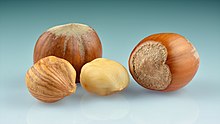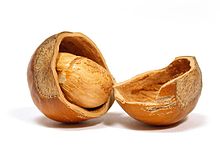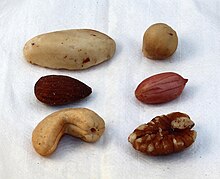
The almond is a species of tree from the genus Prunus cultivated worldwide for its seed, a culinary nut. Along with the peach, it is classified in the subgenus Amygdalus, distinguished from the other subgenera by corrugations on the shell (endocarp) surrounding the seed.
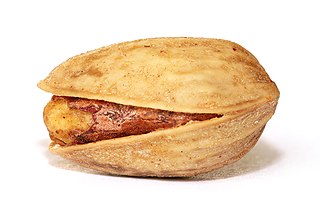
The pistachio, a member of the cashew family, is a small tree originating in Persia. The tree produces seeds that are widely consumed as food. The word can be countable or uncountable, meaning its plural is with or without an 's'.

Nutella is a brand of brown, sweetened hazelnut cocoa spread. Nutella is manufactured by the Italian company Ferrero and was introduced in 1964, although its first iteration dates to 1963.

A nut is a fruit consisting of a hard or tough nutshell protecting a kernel which is usually edible. In general usage and in a culinary sense, a wide variety of dry seeds are called nuts, but in a botanical context "nut" implies that the shell does not open to release the seed (indehiscent).

Macadamia is a genus of four species of trees in the flowering plant family Proteaceae. They are indigenous to Australia, native to northeastern New South Wales and central and southeastern Queensland specifically. Two species of the genus are commercially important for their fruit, the macadamia nut. Global production in 2015 was 160,000 tonnes. Other names include Queensland nut, bush nut, maroochi nut, bauple nut and, in the US, they are also known as Hawaii nut. It was an important source of bushfood for the Aboriginal peoples.
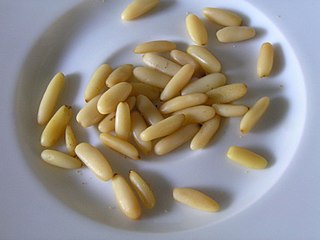
Pine nuts, also called piñón, pinoli, or pignoli, are the edible seeds of pines. According to the Food and Agriculture Organization, only 29 species provide edible nuts, while 20 are traded locally or internationally owing to their seed size being large enough to be worth harvesting; in other pines, the seeds are also edible but are too small to be of notable value as human food. The biggest producers of pine nuts are China, Russia, North Korea, Pakistan and Afghanistan.

Hazels are plants of the genus Corylus of deciduous trees and large shrubs native to the temperate Northern Hemisphere. The genus is usually placed in the birch family Betulaceae, though some botanists split the hazels into a separate family Corylaceae. The fruit of the hazel is the hazelnut.
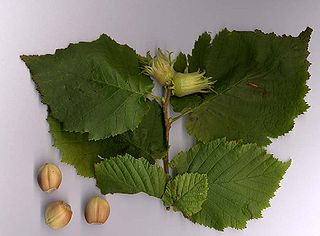
Corylus avellana, the common hazel, is a species of flowering plant in the birch family Betulaceae, native to Europe and Western Asia. It is an important component of the hedgerows that were, historically, used as property and field boundaries in lowland England. The wood was traditionally grown as coppice, with the poles cut being used for wattle-and-daub building, and agricultural fencing.

Corylus maxima, the filbert, is a species of hazel in the birch family Betulaceae, native to southeastern Europe and southwestern Asia, from the Balkans to Ordu in Turkey.

Corylus colurna, the Turkish hazel or Turkish filbert, is a deciduous tree native to southeast Europe and southwest Asia, from the Balkans through northern Turkey to northern Iran.

Juglans regia, the Persian walnut, English walnut, Carpathian walnut, Madeira walnut, or, especially in Great Britain, common walnut, is an Old World walnut tree species native to the region stretching from the Caucasus eastward to the Kashmir region. It is widely cultivated across Asia, Northern America and Europe.

Corylus cornuta, the beaked hazelnut, is a deciduous shrubby hazel with two subspecies found throughout most of North America.
Hazelnut butter or hazelnut paste is a food spread made from crushed and blended hazelnuts. More commonly found in Europe, hazelnut butter is also familiar when mixed with chocolate as an ingredient in chocolate spreads. Hazelnut butter is available in both crunchy and smooth varieties, and can be made from either raw or roasted hazelnuts. Gianduja is also a type of chocolate stretched with hazelnut butter.

Anisogramma anomala is a plant pathogen that causes a disease known as Eastern filbert blight on Corylus spp. (hazlenut). Also known as EFB.

Curculio nucum, the nut weevil, is a medium-sized beetle, with an especially elongated snout, characteristic of the Curculionini tribe of the weevil family (Curculionidae). Its larvae develop in hazel nuts Corylus avellana, being a serious pest in hazelnut orchards. It occurs in most of Europe, from south Sweden, Finland and Great Britain to the Mediterranean.

Gevuina avellana is an evergreen tree, up to 20 meters tall. It is the only species currently classified in the genus Gevuina. It is native to southern Chile and adjacent valleys in Argentina. It is found from sea level to 700 meters above sea level. Its distribution extends from 35° to 44° south latitude. The composite leaves are bright green and toothed, and the tree is in flower between July and November. The flowers are very small and beige to whitish, are bisexual and group two by two in long racemes. The fruit is a dark red nut when young and turns black. The peel is woody. It can grow up straight or branched from the soil, making up either a tree or a shrub.

Corylus americana, the American hazelnut or American hazel, is a species of deciduous shrub in the genus Corylus, native to the eastern and central United States and extreme southern parts of eastern and central Canada.

Corylus jacquemontii is a species of hazel, found in Asia, within the Himalayas and from Afghanistan through to W. Nepal. It is a small tree or shrub, with grey bark, ovate or obovate (teardrop-shaped) leaves, small flowers and small edible nuts, grouped in small clusters.
